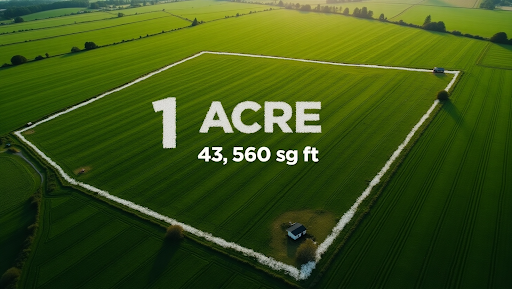
If you’ve ever been curious about land size, you’ve probably asked, “How big is an acre?” Whether you’re buying property, farming, or just trying to visualize space, understanding the size of an acre is essential. This easy guide will explain exactly what an acre is, how big it really is in square feet and other units, and give you practical examples to help you visualize it.
What Is an Acre? Definition and History
An acre is a unit of area commonly used in the United States, the UK, and other countries that measure land, especially in real estate and agriculture. Officially, an acre is defined as 43,560 square feet.
The term “acre” dates back to medieval England, historically referring to the amount of land tillable by one man behind an ox in one day. Over time, it became standardized to the size we know today.
While acres are widely used in many countries, other regions may use different units, like hectares in metric-based systems. Knowing how an acre compares to these units is useful when dealing with international land measurements.
How Big Is an Acre in Square Feet and Other Units?
An acre is exactly 43,560 square feet. To put this into perspective:
- 1 acre = 43,560 square feet
- 1 acre ≈ 4,047 square meters
- 1 acre ≈ 0.4047 hectares
- 1 acre ≈ 0.00156 square miles
These conversions are important when working with different land measurement systems. For example, if you see a plot of land measured in hectares, you can quickly convert it to acres for better understanding.
Visualizing an Acre: Practical Examples
Sometimes numbers don’t paint the full picture. To help you visualize an acre, here are some comparisons:
- An acre is roughly about ¾ of a standard American football field (including the end zones).
- It’s roughly the size of 16 tennis courts placed side by side.
- Another common comparison is a baseball diamond from home plate to second base.
Knowing these references can help you get a real-world sense of the space an acre covers.
How to Measure an Acre of Land
If you need to measure an acre yourself, here are some easy methods:
Manual Measurement
Since an acre is 43,560 square feet, if your land is perfectly square, each side will be approximately 208.7 feet long (because 208.7 x 208.7 ≈ 43,560). You can measure the sides using a tape measure or measuring wheel.
Using Technology
Smartphones today come with GPS and mapping apps that can calculate area. Apps like Google Earth or specialized land measurement tools help measure irregularly shaped plots easily.
Hiring a Surveyor
For accurate and legal measurements—especially important in property sales—hiring a professional surveyor is the best option. They use precise equipment to ensure your land area is correctly recorded.
How Many Acres Are in Other Land Units?
It’s common to encounter different land units depending on the country or industry. Here’s a quick conversion chart to keep handy:
| Unit | Equivalent in Acres |
|---|---|
| 1 Hectare | 2.471 acres |
| 1 Square Mile | 640 acres |
| 1 Square Kilometer | 247.1 acres |
| 1 Square Foot | 0.000023 acres |
Using this chart, you can easily convert between acres and other units, which is especially helpful in global real estate or agriculture contexts.
Common Uses of Acres in Different Industries
Real Estate and Property Sales
Acres are a standard unit for measuring land parcels and lots. Buyers and sellers rely on this measurement to assess property size, value, and potential.
Agriculture and Farming
Farmers use acres to determine the amount of land for crops or livestock grazing. Crop yields and fertilizer amounts are often calculated per acre.
Environmental and Conservation Work
Land conservation projects measure areas in acres to plan preservation efforts or restoration projects.
Why Knowing Acre Size Matters for Buyers and Sellers
Understanding the size of an acre is crucial whether you are buying, selling, or managing land:
- It helps you evaluate the true size of a property, avoiding misunderstandings.
- It allows you to compare land values accurately.
- For developers and farmers, it assists in planning land use, budgeting, and resource allocation.
FAQs About Acre Size
Is an acre the same everywhere?
Yes, an acre is standardized internationally as 43,560 square feet, although some countries may prefer other units like hectares.
How does an acre compare to a hectare?
One hectare is about 2.47 acres, making it larger than an acre.
Can an acre be irregularly shaped?
Yes. An acre refers to area size, not shape. It can be rectangular, square, or any irregular form, as long as the total area is 43,560 sq ft.
How long is the side of a square acre?
Each side of a square acre measures about 208.7 feet.
Conclusion
So, how big is an acre? It’s 43,560 square feet—a size that’s easier to grasp when you think of it as about three-quarters of a football field or 16 tennis courts. Whether you’re buying land, farming, or just curious, knowing the size of an acre helps you visualize and make better decisions about land use.
With this easy guide to acre size, you now have the tools and comparisons needed to understand and measure acres confidently. Next time you hear “acre” mentioned, you’ll know exactly how big it really is.


